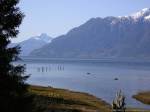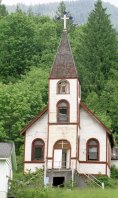It has taken many years, but at last the Homalco Indian Band of Campbell River BC have come full circle; reclaiming  their history on their own ancestral lands. I had the opportunity to accompany 22 Homalco youth, average age in their mid twenties from Campbell River to Orford Bay – the site of their traditional territory in the Bute Inlet. We travelled there in the Kuluta, a boat that amply accommodated all 30 of us and was captained by Discovery Marine Safaris Captain Jeff; with marine biologist Amber in attendance, amid the laughter of the young people who were virtually going into the unknown, on an adventure to discover their own roots.
their history on their own ancestral lands. I had the opportunity to accompany 22 Homalco youth, average age in their mid twenties from Campbell River to Orford Bay – the site of their traditional territory in the Bute Inlet. We travelled there in the Kuluta, a boat that amply accommodated all 30 of us and was captained by Discovery Marine Safaris Captain Jeff; with marine biologist Amber in attendance, amid the laughter of the young people who were virtually going into the unknown, on an adventure to discover their own roots.
The adventure was orchestrated by Shawn O’Connor, who has been working closely with the band for several years. The young people, who grew up on the Homalco’s Campbell River reserve, are going to spend two weeks at Orford Bay where they have never been before. Orford Bay is on the south side of Bute Inlet which is located on the BC mainland coast about a two hour boat trip from Campbell River. They will learn how to provide a cultural experience to visitors coming to their remote home; a home that has so much to offer – world class scenery, abundant opportunities to view grizzly  bears coming to feed in the nearby
bears coming to feed in the nearby  river, and easily accessible seafood. Buildings left from a logging operation house the potential employees, and cooks in the cook house provide food while the young people are in training. An orientation centre on site provides a focal point for the cultural tour and illustrates the Homalco Band history. There has been a hatchery right at the property for several years now and it is staffed by a regular crew who are currently raising chum salmon. The facility at Orford Bay has been in existence for 20 years, but it has only been in the last seven years that a concerted effort has been made to develop tourism potential. In that short time, the spot has been declared the top grizzly bear viewing site in British Columbia. With several excellent towers established along the river banks, it is easy to see how this offers tourists the above average prospect of actually seeing the bears in action, catching and feeding on salmon, usually in the fall.
river, and easily accessible seafood. Buildings left from a logging operation house the potential employees, and cooks in the cook house provide food while the young people are in training. An orientation centre on site provides a focal point for the cultural tour and illustrates the Homalco Band history. There has been a hatchery right at the property for several years now and it is staffed by a regular crew who are currently raising chum salmon. The facility at Orford Bay has been in existence for 20 years, but it has only been in the last seven years that a concerted effort has been made to develop tourism potential. In that short time, the spot has been declared the top grizzly bear viewing site in British Columbia. With several excellent towers established along the river banks, it is easy to see how this offers tourists the above average prospect of actually seeing the bears in action, catching and feeding on salmon, usually in the fall.
To make the bear viewing business feasible, the Band has partnered with companies like Discovery Marine Safaris that have the right type of vessel for getting groups of people to this distant location.
The cultural experience and tour is new, and the focus is on Homalco tradition instead of wildlife viewing. It doesn’t mean that participants on the cultural tour won’t see wildlife; on our trip, we were thrilled to see white sided dolphins, porpoises and killer whales while travelling on the boat. Elk reside at Orford Bay, transplanted there from Vancouver Island about six years ago, and according to John, the camp manager, from a small herd of 16 there are now two herds of about 20 elk each. One of the bear viewing guides Janet, warned us that a young male grizzly had been seen around the property in the last few days, but he didn’t come around while we were there.
Janet also explained that the name Homalco means ‘people of turbulent, or fast running water’. Their history is sadly a story of displacement far from the water for which they are named. The Homalco language is a Coast Salish dialect, and their core traditional territory extends from Dent Island to the vicinity of Raza Passage and includes all of Bute Inlet.
Since European contact, they were relocated first to the village site of Muushkin (old Church House) on Sonora Island but as the winds were too fierce there and most of the buildings blew down one winter, they were relocated once again to the opposite side of Calm Channel just south of the mouth of Bute Inlet. There they built a lovely white church, and as John said,  he didn’t know how they did it, not having a blueprint. At right is a picture of the church. The church became their spiritual symbol and was a well known landmark along the coast for many years. However, when the last of the Homalco left in 1988 to live on the reserve in Campbell River, the church slowly deteriorated and by 2007 had completely fallen. Being removed from their ancestral lands proved to be very costly to the Homalco, who lost the ability to support themselves by living off the land, then later commercial fishing. They witnessed the dissolution of their society and became distanced not just geographically but spiritually from their origins and their traditional beliefs, that had always been firmly rooted in the land.
he didn’t know how they did it, not having a blueprint. At right is a picture of the church. The church became their spiritual symbol and was a well known landmark along the coast for many years. However, when the last of the Homalco left in 1988 to live on the reserve in Campbell River, the church slowly deteriorated and by 2007 had completely fallen. Being removed from their ancestral lands proved to be very costly to the Homalco, who lost the ability to support themselves by living off the land, then later commercial fishing. They witnessed the dissolution of their society and became distanced not just geographically but spiritually from their origins and their traditional beliefs, that had always been firmly rooted in the land.
Now a number of the Homalco are returning to their true home to spend time there, at least seasonally, in an effort to reconnect with their past. As they learn with the help of other First Nations groups who offer cultural tours, they will develop the skills necessary to convey their story and traditions to others. A plan is already in place: visitors will be taken out on a traditional Salish design canoe for a paddle, will see a demonstration of cedar weaving and learn how to weave a simple piece, they will learn Homalco history and visit with a Homalco artist, then will partake in a traditional seafood feast. If local wildlife make an appearance that will be a bonus!
Even those of us who live in coastal BC don’t always get a chance to get up into these faraway inlets to enjoy their outstanding beauty, and very few of us are ever given the opportunity to visit a First Nations reserve and to experience their ancient culture. It was genuinely heart warming to see the enthusiasm of these Homalco youth who voluntarily left home to reconnect with their ancestors’ home, and to see their willingness to step into an entirely new experience.
I am excited about participating in the first trip to Orford Bay on May 31st and being part of the new cultural tour. There will be a second tour on June 21st, Aboriginal Day. I will be going as a guide for the Museum at Campbell River and will be discussing settlement and Coast Salish history on the way there as we travel by boat through the Discovery Islands and up the Bute to Orford Bay. Once we land, the Homalco will paddle out in their canoe to greet us and take us on their highly personal tour; relating the story of a long long journey of displacement before coming back to their own lands in the beautiful Bute.








Hi, I am presently reading A Small and Charming World, by John Gibson, who worked for the federal government TRYING to assist the natives in their lives, and this little place was mentioned and I was so curious to see it. thanks now to technology I can. Love the church, as John mentions many churches in his book,,,what a huge struggle he had to help the people all over the north. Our government should hang their heads in much shame on how they treated these people…I honestly believe in my heart of hearts, had they left them all alone, they would have survived healthier and happier, in their own world.
Thank-you for you comment. I will look for that book as it sounds very interesting!
Pingback: Dave Flawse reviews Up the Coast by Kathryn Willcock